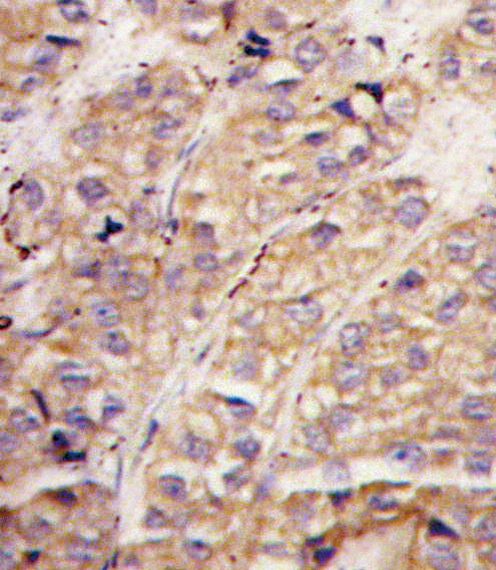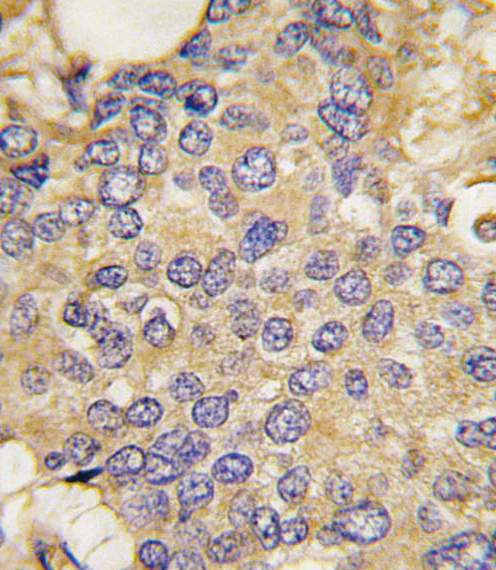SMURF1 Antibody (N-term)
Purified Rabbit Polyclonal Antibody (Pab)
- 产品详情
- 文献引用 : 4
- 实验流程
- 背景知识
Application
| WB, IHC-P, E |
|---|---|
| Primary Accession | Q9HCE7 |
| Other Accession | Q2TAS2, A2A5Z6, Q9HAU4, A9JRZ0, Q9PUN2, Q9CUN6 |
| Reactivity | Human, Mouse, Rat |
| Predicted | Zebrafish, Xenopus |
| Host | Rabbit |
| Clonality | Polyclonal |
| Isotype | Rabbit IgG |
| Calculated MW | 86114 Da |
| Antigen Region | 66-96 aa |
| Gene ID | 57154 |
|---|---|
| Other Names | E3 ubiquitin-protein ligase SMURF1, hSMURF1, 632-, SMAD ubiquitination regulatory factor 1, SMAD-specific E3 ubiquitin-protein ligase 1, SMURF1, KIAA1625 |
| Target/Specificity | This SMURF1 antibody is generated from rabbits immunized with a KLH conjugated synthetic peptide between 66-96 amino acids from the N-terminal region of human SMURF1. |
| Dilution | WB~~1:1000 IHC-P~~1:100~500 E~~Use at an assay dependent concentration. |
| Format | Purified polyclonal antibody supplied in PBS with 0.09% (W/V) sodium azide. This antibody is prepared by Saturated Ammonium Sulfate (SAS) precipitation followed by dialysis against PBS. |
| Storage | Maintain refrigerated at 2-8°C for up to 2 weeks. For long term storage store at -20°C in small aliquots to prevent freeze-thaw cycles. |
| Precautions | SMURF1 Antibody (N-term) is for research use only and not for use in diagnostic or therapeutic procedures. |
| Name | SMURF1 |
|---|---|
| Synonyms | KIAA1625 |
| Function | E3 ubiquitin-protein ligase that acts as a negative regulator of BMP signaling pathway. Mediates ubiquitination and degradation of SMAD1 and SMAD5, 2 receptor-regulated SMADs specific for the BMP pathway. Promotes ubiquitination and subsequent proteasomal degradation of TRAF family members and RHOA. Promotes ubiquitination and subsequent proteasomal degradation of MAVS (PubMed:23087404). Acts as an antagonist of TGF-beta signaling by ubiquitinating TGFBR1 and targeting it for degradation (PubMed:21791611). Plays a role in dendrite formation by melanocytes (PubMed:23999003). |
| Cellular Location | Cytoplasm. Cell membrane; Peripheral membrane protein; Cytoplasmic side |
| Tissue Location | Expressed in melanocytes (PubMed:23999003). |
For Research Use Only. Not For Use In Diagnostic Procedures.

Provided below are standard protocols that you may find useful for product applications.
BACKGROUND
Members of the transforming growth factor-beta (TGFB) family signal through type I and type II serine/threonine-kinase receptors, which in turn activate the SMAD signaling pathway. Bone morphogenetic protein (BMP) receptors target SMAD1, SMAD5, and SMAD8, whereas receptors for activin and TGFB (e.g., ACVR1 and TGFBR1, respectively) target SMAD2 and SMAD3. Phosphorylation of these receptor-regulated SMADs induces their association with the common-partner SMAD, SMAD4. Smurf1, a HECT domain E3 ubiquitin ligase, regulates cell polarity and protrusive activity and is required to maintain the transformed morphology and motility of a tumor cell. Atypical protein kinase C-zeta (PKC2), an effector of the Cdc42/Rac1-PAR6 polarity complex, recruits Smurf1 to cellular protrusions, where it controlled the local level of RhoA. Smurf1 thus links the polarity complex to degradation of RhoA in lamellipodia and filopodia to prevent RhoA signaling during dynamic membrane movements.
REFERENCES
Tajima, Y., et al., J. Biol. Chem. 278(12):10716-10721 (2003). Suzuki, C., et al., J. Biol. Chem. 277(42):39919-39925 (2002). Ebisawa, T., et al., J. Biol. Chem. 276(16):12477-12480 (2001). Zhu, H., et al., Nature 400(6745):687-693 (1999). Lambris, J., et al., J. Immunol. Methods 27(1):55-59 (1979).
终于等到您。ABCEPTA(百远生物)抗体产品。
点击下方“我要评价 ”按钮提交您的反馈信息,您的反馈和评价是我们最宝贵的财富之一,
我们将在1-3个工作日内处理您的反馈信息。
如有疑问,联系:0512-88856768 tech-china@abcepta.com.






















 癌症的基本特征包括细胞增殖、血管生成、迁移、凋亡逃避机制和细胞永生等。找到癌症发生过程中这些通路的关键标记物和对应的抗体用于检测至关重要。
癌症的基本特征包括细胞增殖、血管生成、迁移、凋亡逃避机制和细胞永生等。找到癌症发生过程中这些通路的关键标记物和对应的抗体用于检测至关重要。 为您推荐一个泛素化位点预测神器——泛素化分析工具,可以为您的蛋白的泛素化位点作出预测和评分。
为您推荐一个泛素化位点预测神器——泛素化分析工具,可以为您的蛋白的泛素化位点作出预测和评分。 细胞自噬受体图形绘图工具为你的蛋白的细胞受体结合位点作出预测和评分,识别结合到自噬通路中的蛋白是非常重要的,便于让我们理解自噬在正常生理、病理过程中的作用,如发育、细胞分化、神经退化性疾病、压力条件下、感染和癌症。
细胞自噬受体图形绘图工具为你的蛋白的细胞受体结合位点作出预测和评分,识别结合到自噬通路中的蛋白是非常重要的,便于让我们理解自噬在正常生理、病理过程中的作用,如发育、细胞分化、神经退化性疾病、压力条件下、感染和癌症。








